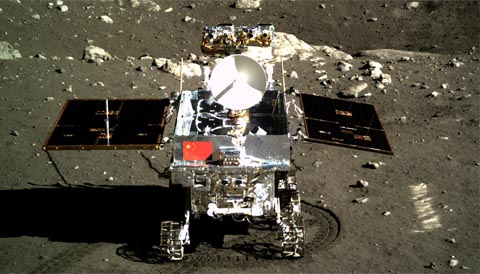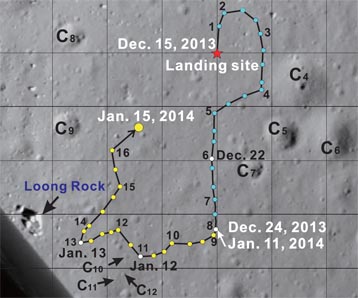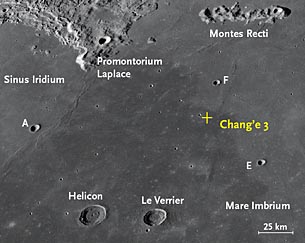A radar sounder aboard China's first-ever lunar lander found at least nine discrete subsurface layers at its landing site in northern Mare Imbrium.

Chinese Academy of Sciences
When China's Chang'e 3 spacecraft came to rest atop northern Mare Imbrium on December 14, 2013, it achieved the first soft landing on the Moon since 1976. Within a day, the Chinese National Space Administration released captivating video of a small, six-wheeled rover called Yutu ("Jade Rabbit") trundling down a ramp and onto the dusty lunar surface.
The main spacecraft and rover each carried four instruments. On the lander were three cameras and a small ultraviolet telescope for monitoring Earth's hydrogen plasmasphere and other celestial targets. Yutu got the geoscience payload: a wide-field camera, visible-infrared imaging spectrometer, X-ray spectrometer, and ground-penetrating radar. These experiments worked well for more than a year (Chang'e 3's nominal lifetime) — in fact, a few months ago mission scientists showcased their results in a 16-article special issue of the Chinese journal Research in Astronomy and Astrophysics (the articles are in English).

Science / Y. Xiao & others
(If you just want to sightsee, the Chinese Academy of Sciences has posted a nice gallery of images from Chang'e 3 and Yutu. And don't miss the video taken by Chang'e 3 during its descent to the lunar surface. For context, peruse the collection of views looking down on Chang'e 3 and Yutu taken by NASA's Lunar Reconnaissance Orbiter.)
Plans called for Yutu to travel up to 10 km (6 miles) over three months, but a mechanical malfunction prevented its solar-cell panels from closing to help insulate the craft's interior during the long lunar night. So it only managed to traverse about 114 meters (375 feet) along a zigzag route that ended up about 20 m (65 feet) to the southwest of the lander. Yet Yutu made the most of its limited mobility, venturing to the lip of a nearby crater about 450 m (0.25 mile) across.
In Science for March 13th, mission scientists led by Long Xiao (China University of Geosciences) report results from the ground-penetrating radar, which operated at 500 megahertz (MHz) to probe the lunar landscape to depths of to 12 m (40 feet) and at 60 MHz to reveal structures down to about 400 m (0.25 mile).

NASA / Arizona State University
This area of Mare Imbrium is known to be crisscrossed by multiple lava flows, and Xiao's team has mapped at least nine discrete subsurface rock layers. The deepest ones represent lava that flowed over the region some 3.3 billion years ago. Higher up are flows that the researchers think are significantly younger, 2.5 billion years old, based on prior geologic analysis of Mare Imbrium's evolution. S&T contributing editor Charles Wood points out that this young flow can be observed visually just to the west of the landing site as a dark expanse overlying the lighter-hued older unit.
But the topmost pair of layers detected by Yutu's radar, which vary in thickness but together average about 4 m, appear to be rubble thrown out by that sizable nearby crater. Based on the number of small craters surrounding it, the researchers estimate that it formed 27 to 80 million years ago. Here and there along Yutu's track, the radar echoes also revealed what are probably buried boulders tossed out when the crater formed.
Lunar scientists certainly expected near-surface layering underneath Chang'e 3, but, as Xiao's team concludes, "there is more complex geologic history than we had thought."
You can explore the lunar landscape yourself with Sky & Telescope's new lunar globes. Choose either the natural-hued Moon you see by eye or the color-coded topographic version.
 3
3
Comments
Graham-Wolf
March 17, 2015 at 12:19 am
One normally associates space exploration with just the USA and Russia. Now, there is a 3rd and equally powerful player in this genre.... China.
Their efforts really need to be taken more seriously.... it's been a long time since either the USA or Russia did something of this sheer magnitude. A lot of technology and raw science was clearly needed to make this Lunar Lander mission physically happen. And they have certainly succeeded.
Congratulations and well done, China!
Mare Inbrium will never be the same again (in the nicest possible way).
Graham W. Wolf at Lower Hutt, New Zealand.
You must be logged in to post a comment.
Dieter Kreuer
March 17, 2015 at 8:25 am
@Graham Wolf
You forgot about one space agency that has sent probes to Halley's comet (Giotto), Mars (Mars Express), the Moon (SMART-1), Venus (Venus Express), that landed on Titan (Huygens) and comet Churyomov-Gerassimenko (Rosetta/Philae), and that contributed to SOHO, Ulysses, the Hubble Space Telescope, the ISS and many other projects. Also, India has a Mars Orbiter, while Japan even brought pieces of an asteroid back to Earth (and will hopefully have a probe in Venus orbit by the end of this year). China is at no. 5 in unmanned space exploration. In manned spaceflight, they are no. 3, because European leaders canceled the development of a small spaceplane, Hermes, which originally was to be one of the main payloads of the Ariane V rocket. Human spaceflight has never been that much a prestige program as it was and is for other countries (unfortunately, I should add, being a spaceflight enthusiast).
You must be logged in to post a comment.
Graham-Wolf
March 19, 2015 at 1:02 am
You're perfectly correct Dieter.
My carelessness, and somewhat confusing message.
Mea Culpa.
I was actually referring to Lunar Landings.
ESA has indeed been a very powerful space player.... I've fond memories of Giotto, as you clearly have, and yes, they have carried out equally remarkable missions, that you have wonderfully outlined. Correct again.... India has indeed a lunar orbiter. In manned spaceflight China is indeed at number 3.... those Taikonauts just a few short years ago (brief Earth orbital missions).
Very observant comments... Dieter. I now stand firmly corrected, and commend you for your detail.
Warmest regards
Graham W. Wolf:- Lower Hutt, New Zealand
You must be logged in to post a comment.
You must be logged in to post a comment.